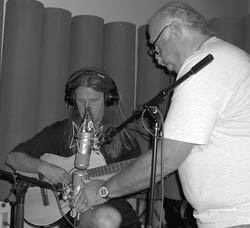
In essence, I could say that I use the unpainted, plywood surface of the drum platform to reflect Michael’s vocal sound source, surrounded by Tube Traps, back to the microphone.
This also preserves the rhythmic effect of him dancing happily away while he sings. I think that is an important part of Michael’s sonic character.
In fact, I have used them on all my projects since 1987. No matter where I go, I take these wonderful devices with me.
I’m sure you have figured out by now that when I go from studio to studio all over the world with all of my equipment and microphones, it is a big deal to move all this stuff.
Quincy Jones says that moving me from studio to studio is like moving the Fifth Army!
Transient Response
I am frequently asked to define transient response, as it applies to music recording. Here are some of my thoughts on this very important subject.
First let’s try to define the basic issue:
—In electronic recording equipment, transient response is the ability of a device or electronic component to handle and faithfully reproduce sudden waveforms called transients. A transient is a short-duration, high-level sonic energy peak, such as a hand-clap or snare drum hit.
Any sound source in the percussion family requires excellent transient response in the recording equipment to sound real.
—To me, a sound transient is the steep wave-front of the sound. In other words, the transient of the sound is the first impact of the sound before the sound falls and begins to decay, or die.
Good transient response is especially important when recording acoustic instruments. This is one case where it’s extremely important or one to have equipment that is able to accurately capture as much of the initial transient and all its accompanying delicate details.
In the music that I am normally involved in, I have always felt compression and limiting diminish the drama of sound-source transients in recorded music.
Along that same line of thinking, I should also point out that I have never been (and probably never will be) a big fan of dynamics compression anywhere during the recording process.
When R&B and pop recordings are over-compressed and over-limited, they lack the extremely fundamental qualities of both primitive energy and smooth high frequencies.
The reason that over-compressed and over-limited recordings lose high-end energy is that much of the sound energy in a recording is concentrated in the lower frequencies.
These low-end signals negatively influence a wide-band compressor’s operation, causing higher frequencies to be attenuated during peaks in level, making the music sound dull and lifeless.
I love transients and what they do to dramatize music. Let them live! If a recording is over-compressed, it will always be over-compressed.
In other words, it will sound dull and lifeless forever.
This is an excerpt from Bruce Swedien’s “Make Mine Music.” To acquire a copy of this book, click over to www.musicdispatch.com
